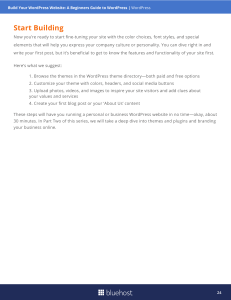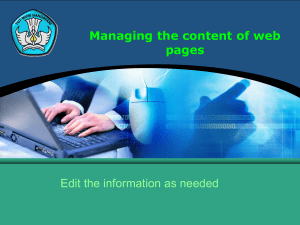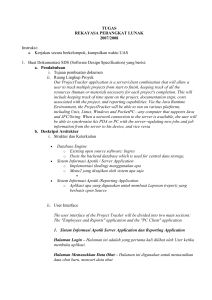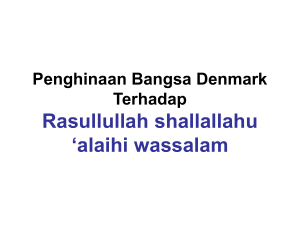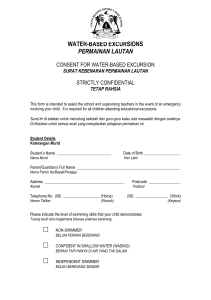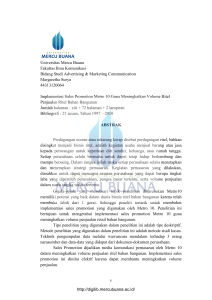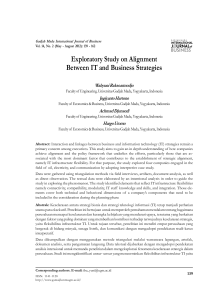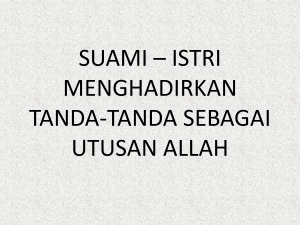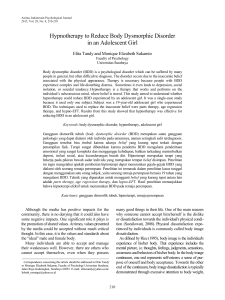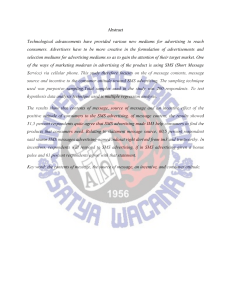Program A - Communication And Research Learning Center
advertisement
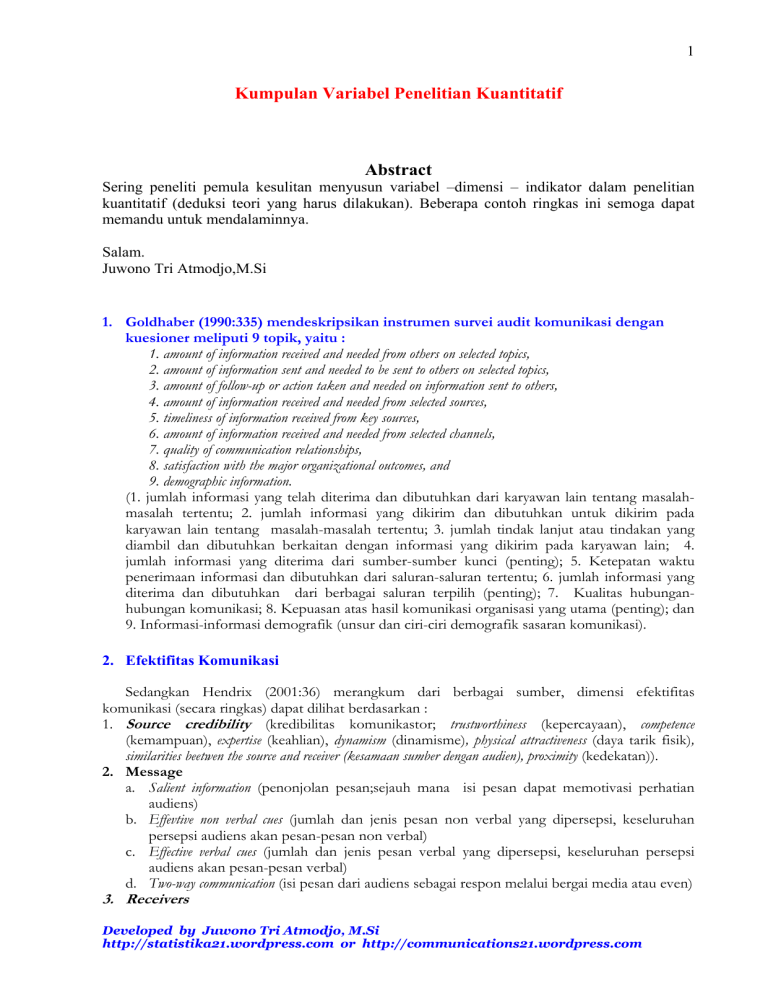
1 Kumpulan Variabel Penelitian Kuantitatif Abstract Sering peneliti pemula kesulitan menyusun variabel –dimensi – indikator dalam penelitian kuantitatif (deduksi teori yang harus dilakukan). Beberapa contoh ringkas ini semoga dapat memandu untuk mendalaminnya. Salam. Juwono Tri Atmodjo,M.Si 1. Goldhaber (1990:335) mendeskripsikan instrumen survei audit komunikasi dengan kuesioner meliputi 9 topik, yaitu : 1. amount of information received and needed from others on selected topics, 2. amount of information sent and needed to be sent to others on selected topics, 3. amount of follow-up or action taken and needed on information sent to others, 4. amount of information received and needed from selected sources, 5. timeliness of information received from key sources, 6. amount of information received and needed from selected channels, 7. quality of communication relationships, 8. satisfaction with the major organizational outcomes, and 9. demographic information. (1. jumlah informasi yang telah diterima dan dibutuhkan dari karyawan lain tentang masalahmasalah tertentu; 2. jumlah informasi yang dikirim dan dibutuhkan untuk dikirim pada karyawan lain tentang masalah-masalah tertentu; 3. jumlah tindak lanjut atau tindakan yang diambil dan dibutuhkan berkaitan dengan informasi yang dikirim pada karyawan lain; 4. jumlah informasi yang diterima dari sumber-sumber kunci (penting); 5. Ketepatan waktu penerimaan informasi dan dibutuhkan dari saluran-saluran tertentu; 6. jumlah informasi yang diterima dan dibutuhkan dari berbagai saluran terpilih (penting); 7. Kualitas hubunganhubungan komunikasi; 8. Kepuasan atas hasil komunikasi organisasi yang utama (penting); dan 9. Informasi-informasi demografik (unsur dan ciri-ciri demografik sasaran komunikasi). 2. Efektifitas Komunikasi Sedangkan Hendrix (2001:36) merangkum dari berbagai sumber, dimensi efektifitas komunikasi (secara ringkas) dapat dilihat berdasarkan : 1. Source credibility (kredibilitas komunikastor; trustworthiness (kepercayaan), competence (kemampuan), expertise (keahlian), dynamism (dinamisme), physical attractiveness (daya tarik fisik), similarities beetwen the source and receiver (kesamaan sumber dengan audien), proximity (kedekatan)). 2. Message a. Salient information (penonjolan pesan;sejauh mana isi pesan dapat memotivasi perhatian audiens) b. Effevtive non verbal cues (jumlah dan jenis pesan non verbal yang dipersepsi, keseluruhan persepsi audiens akan pesan-pesan non verbal) c. Effective verbal cues (jumlah dan jenis pesan verbal yang dipersepsi, keseluruhan persepsi audiens akan pesan-pesan verbal) d. Two-way communication (isi pesan dari audiens sebagai respon melalui bergai media atau even) 3. Receivers Developed by Juwono Tri Atmodjo, M.Si http://statistika21.wordpress.com or http://communications21.wordpress.com 2 a. Opinion leaders (pertama; posisi opinion leader, posisi formal/non formal, dan pengaruh opinion leader pada audien lain. Kedua; terpaan pesan langsung/satu tahap , dua tahap atau banyak tahap). b. Group influence (kedekatan antar anggota/members cohesiveness, kebersamaan, keuntungan bersama, interaksi tatap muka dan pengaruhnya pada anggota lain, nilai dan norma bersama, tingkat konformitas antar anggota/degree of conformity by each member) c. Selective exposure (sejauhmana sikap atau perilaku audien sulit untuk dirubah dsb) 4. Audience participation (feedback; partisipasi audiens pada event, pertayaan audien, pengiriman e-mail, telepon, sebagai member organisasi dsb) Variabel Efektifitas Komunikasi Dimensi Efektifitas Komunikasi Hendrix (2001:36) Indikator Source credibility a. b. c. d. e. f. Message a. Salient information (penonjolan pesan) b. Effevtive non verbal cues (jumlah dan jenis pesan non verbal yang dipersepsi) c. Effective verbal cues (jumlah dan jenis pesan verbal yang dipersepsi) d. Two-way communication (isi pesan dari audiens sebagai respon melalui bergai media atau even) Receivers a. Opinion leaders b. Group influence c. Selective exposure (kredibilitas Sumber) Audience participation Skala Skala Likert; trustworthiness (kepercayaan), competence (kemampuan), Sangat Setuju expertise (keahlian), Setuju dynamism (dinamisme), Ragu-ragu physical attractiveness (daya tarik fisik), Tidak Setuju similarities beetwen the source and Sangat Tidak receiver (kesamaan sumber dengan Setuju audien), proximity (kedekatan)). feedback; partisipasi audiens pada event, pertayaan audien, pengiriman e-mail, telepon, sebagai member organisasi dsb Developed by Juwono Tri Atmodjo, M.Si http://statistika21.wordpress.com or http://communications21.wordpress.com 3 3. Efektifitas komunikasi organisasi Harjana (2000:23) Harjana (2000:23) mengemukakan Efektifitas komunikasi organisasi kriteria yang digunakan adalah siapa penerima atau pemakai (receiver or user), isi pesan (content), ketepatan waktu (time), media komunikasi (media), format (format), dan sumber pesan (source)...efisiensi komunikasi dengan kriteria biaya (cost), waktu (time), ketepatan (accuracy) dan kejelasan pengertian (intelligibility). Variabel Efektifitas Komunikasi Efektifitas Komunikasi Harjana (2000:23) Dimensi Indikator Skala • penerima pesan yang sebenarnya vs Skala Likert; penerima yang dituju (ketepatan Sangat Setuju penerima pesan) Setuju • Isi yang diterima vs isi yang Ragu-ragu dimaksudkan Tidak Setuju Sangat Tidak Ketepatan waktu • sesuai jadwal vs penyimpangan Setuju jadwal • Pesan diterima (tepat/tidak) pada saat dibutuhkan Penerima/ Pemakai Isi Media • saluran yang digunakan vs saluran yang seharusnya • Kualitas Media • Jenis Media • Ketepatan isi pada media yg digunakan Isi Pesan • • • • • • Format Sumber Isi Informasi tentang..... Kelengkapan isi Kejelasan Isi Kemudahan dipahami Pesan up to date struktur yg diterima vs struktur yang dikirim • orang yang menyampaikan vs orang seharusnya menyampaikan • Kredibilitas sumber • Kompetensi sumber menyampaikan pesan • Kelengkapan sumber Developed by Juwono Tri Atmodjo, M.Si http://statistika21.wordpress.com or http://communications21.wordpress.com 4 4. Efisiensi Program komunikasi Variabel Efisiensi Program komunikasi Dimensi Biaya Indikator Skala • Biaya nyata vs biaya menurut Skala Likert; rencana Waktu • Waktu yang dibutuhkan vs waktu yg direncanakan untuk distribusi informasi Ketepatan • Jumlah kesalahan pesan kesalahan minimun direncanakan Penangkapan pesan Sangat Setuju Setuju Ragu-ragu Tidak Setuju Sangat Tidak Setuju vs yg • Tingkat kesulitan nyata daya tangkap khalayak vs tingkat kesulitan yang diperkirakan. Developed by Juwono Tri Atmodjo, M.Si http://statistika21.wordpress.com or http://communications21.wordpress.com 5 5. Profil Komunikasi keorganisasian Kepuasan Organisasi Variabel Kepuasan Organisasi Dimensi Indikator Kepuasan Karyawan Kerja pada organisasi Supervisi Gaji &tunjangan Fasilitas Promosi Karyawan Teman sejawat Kerja Iklim Komunikasi Keorganisasian Pengalaman & Persepsi Karyawan proses komunikasi organisasi Kualitas Media Persepsi tentang tertulis. karyawan dokumen Skala Skala Likert; Sangat Setuju Setuju Ragu-ragu Tidak Setuju Sangat Tidak Setuju Kepercayaan/saling percaya Partisipasi dlm pengambilan keputusan Pemberian dukungan Keterbukaan komunikasi dg bawahan Kerelaan mendengar bawahan Daya tarik untuk dibaca Cocok (sesuai) dengan kebutuhan Terpercaya (dpt diandalkan) Mudah dipahami Lengkap dan jelas Efisien Developed by Juwono Tri Atmodjo, M.Si http://statistika21.wordpress.com or http://communications21.wordpress.com 6 6. Kemudahan memperoleh informasi Variabel Penyebaran Dimensi Indikator Distribusi informasi • informasi • • Kemudahan memperoleh informasi Persepsi karyawan tentang perolehan informasi dari berbagai sumber Muatan informasi Persepsi informasi diterima Kemurnian Pesan Kejelasan pesan pada yang Skala Penyebaran Informasi dalam Skala Likert; struktur organisasi Sangat Penting/tidaknya Setuju Peristiwa terkini (berita)dsb Setuju Atasan langsung Ragu-ragu Kelompok tertentu Tidak Bawahan Setuju Kolega Sangat Dokumen-penerbitan Tidak Obrolan lisan Setuju Kecukupan informasi, Kekurangan informasi, Kelebihan informasi, dan Terlewatkan dr berbagai informasi (terisolasi) Perbedaan pesan yang dimengerti dan sebenarnya ada, kesalahan dan penghapusan pesan. Budaya organisasi Persepsi dan • (pengrertian, perhatian, mau pengalaman mendengar, komunikatif, Karyawan tentang : membantu, mendorong) • (baik, jasa, kualitas, pelayanan Relasi prima). • (bersih, rapi, teratur, Nilai-nilai aman,tertip ) Lingkungan Sumber : Wayne (1994) dalam Hardjana (1997:55-56) dimodifikasi penulis Developed by Juwono Tri Atmodjo, M.Si http://statistika21.wordpress.com or http://communications21.wordpress.com 7 7. Communication Competence Variabel Communication Competence Dimensi Knowledge comunicate Skala to Skala Likert; Skill to comunicate Motivations comunicate to Sangat Setuju Setuju Ragu-ragu Tidak Setuju Sangat Tidak Setuju 8. Reputations Measurement To begin to understand the value of reputation, we must conceptualize more specifically how and why public relations adds value. In their study for the Council of Public Relations Firms, Jeffries-Fox Associates (2000b) searched the business, public relations, and marketing literature for explanations of why reputation has value for an organization. The literature suggested the following benefits of reputation: • Increasing market share. • Lowering market costs. • Lowering distribution costs. • Being able to charge a premium. • Avoiding over-regulation. • Being able to weather bad times. • Greater employee alignment and productivity. • Being able to attract and retain talent. • Being able to attract investors. • Being able to gain access to new global markets. • Gaining more favorable media coverage. (p. 4) Developed by Juwono Tri Atmodjo, M.Si http://statistika21.wordpress.com or http://communications21.wordpress.com 8 9. Relationship Valeus L. Grunig, J. Grunig, and Dozier (2002) described the value of relationships as follows: • Relationships (and their product reputation) provide a context for behavior by consumers, investors, employees, government, the community, the media, and other strategic constituencies—but they do not determine this behavior alone. The behavior of these constituencies affects financial performance; but many other factors, such as competition and the economic environment, also affect that performance. • Relationships save money by preventing costly issues, crises, regulation, litigation, and bad publicity. It is not possible, however, to determine the cost of something that did not happen or even to know that the negative event or behavior would have happened in the absence of excellent public relations. • The return on relationships is delayed. Organizations spend money on relationships for years to prevent events or behaviors such as crises, boycotts, or litigation that might happen many years down the road. • The return on relationships usually is lumpy. Good relationships with some constituencies such as consumers may produce a continuing stream of revenue, but for the most part the return comes all at once—e.g., when crises, strikes, boycotts, regulation, litigation, or bad publicity are avoided or mitigated. Similarly, relationships with potential donors must be cultivated for years before a donor makes a major gift. As a result, it is difficult to prorate the delayed returns on public relations to the monies invested in the function each year. (p. 105) Developed by Juwono Tri Atmodjo, M.Si http://statistika21.wordpress.com or http://communications21.wordpress.com 9 10. Mengukur reputasi Berikut ini saya menemukan di Internet penjelasan lebih dalam mengenai model Harris-Fombrun (source: www.valuebasedmanagement.net/methods_corporate_reputation_quotient.html ): Emotional Appeal - good feeling about the company - admire and respect the company - trust the company Products and Services - stands behind products/services - offers high quality products/services - develops innovative products/services - offers products/services that are good value Vision and Leadership - has excellent leadership - has a clear vision for the future - recognizes/takes advantage of market opportunities Workplace Environment - is well managed - looks like a good company to work for - looks like it has good employees Financial Performance - record of profitability - looks like a low risk investment - strong prospects for future growth - tends to outperform its competitors Social Responsibility - supports good causes - environmentally responsible - treats people well Developed by Juwono Tri Atmodjo, M.Si http://statistika21.wordpress.com or http://communications21.wordpress.com 10 11. Apakah Reputasi bisa diukur? Selama beberapa tahun ini, banyak publikasi majalah Fortune (US) dan BRW Most Admired Companies and Business Leaders mempergunakan pengukuran yang berbeda, yakni: A. Majalah Fortune: 1. Quality Management. 2. Quality of products and services. 3. Innovation. 4. Long Term investment value. 5. Financial soundness 6. Ability to attract, develop, and retain talent. 7. Responsibility to the community and the environment. 8. Wise use of corporate assets 9. Global business acumen. B. Majalah BRW: 1. Long-term shareholder value. 2. High-quality products, services. 3. Innovation. 4. Capacity to deliver growth. 5. Strong corporate brand image. 6. Ability to attract, develop, and retain talent. 7. Commitment to the community environment. 8. Effective use of corporate assets. 9. Customer relationship management. 10. Effective use of new technology. 11. Successful deployment of intellectual capital. Developed by Juwono Tri Atmodjo, M.Si http://statistika21.wordpress.com or http://communications21.wordpress.com 11 12. APPLIED PUBLIC RELATIONS, Cases in Stakeholder Management, Larry F. Lamb University of North Carolina-Chapel Hill Kathy Brittain McKee Berry College, Lawrence Erlbaum Associates, Inc., Publishers 10 Industrial Avenue Mahwah, New Jersey 07430, ,2005, p.5 Public Relations: Stakeholder Relationships m • Understand the Practices: Critique the actions or reactions undertaken by the organization and its publics described here. Are they in line with accepted best practices? Identify the phases of the comunication or campaign cycle and the strengths and weaknesses of the plan and actions. In your opinion, were actions taken that were not necessary? Were other appropriate actions not included? Were there factors of timing and budgeting that impacted actions, or that could have been exploited to better advantage? • Identify the Principles: What are the implications of this case for maintaining mutually beneficial relationships with the key stakeholder identified, or other strategic stakeholders? How does this case illustrate, either positively or negatively, common ethical principles for effective practice? What does this case suggest in terms of effective principles for public relations practitioners in other situations with the same stakeholder or others? The following questions may help you clarify aspects of the cases as you analyze these levels: a. What goal(s) and objectives do you think this organization is attempting to achieve through its actions or reactions? b. What would characterize a mutually beneficial relationship with this public or stakeholder? What would motivate members of that stakeholder group to enter into or to maintain a relationship with this organization? What might be a liability or caution about an ongoing relationship? c. Does this organization's actions demonstrate open- or closed-system practices and philosophies? What type of research do you believe was used in order to develop this plan of action? What more should the organization have known in order to more effectively plan and execute its communication program or campaign? d. What ethical philosophies or precepts are demonstrated by the organization in this case? e. Are there other examples you can cite of organizations that have faced similar challenges? What do those examples tell you about how this organization might have improved its relationships and its outcomes? f. What style of internal management does this case illustrate? Does it appear that public relations practitioners within the organization are taken seriously? Is public relations a management function within this organization? Developed by Juwono Tri Atmodjo, M.Si http://statistika21.wordpress.com or http://communications21.wordpress.com 1 12 Realitas (Realitas Ada nyata – ada tidak nyata) Obyek Riset/apa yang diteliti Aplikasi Proses Riset Masalah Eksplanasi/Deduksi KonfirmasiÎPemahaman seting penelitian Desain Penelitian Tujuan Penelitian Metodologi /Metode/ Strategi Penelitian Teori-teori dari pendekatan Obyektif, sampai Teori dari pendekatan subyektif ? Beberapa Desain Penelitian : Eksplorasi Deskripsi Evaluasi Komparasi Korelasional Kausal Komparasi Analitic dsb Hasil Penelitian Developed by Juwono Tri Atmodjo, M.Si http://statistika21.wordpress.com or http://communications21.wordpress.com Model Penelitian Unsur-unsur Penelitian Format Penelitian Penulisan Laporan Penelitian 13 1 Mass Media Research Map Print Media studies (Readership studies) Reader Profile Itemselection studies Metode Demografic sumarrary Dimensi : Jenis kelamin Life Style Metode Survey Segmentation Usia Pendidikan (Hobies, Penghasilan Activities, Media yang interest, and digunakan attitude. Cara memperoleh media dsb. Iided recall (responden remember) Eksperimen/quasi eksperimen Reader-non (frekuensi, durasi, demografi dsb) antara Metode Survey reader studies Pembaca dengan bukan pembaca Uses and Gratifications studies (Katz) Uses And Effect (Severin Windhal) Social and Psycolo gy factor Motive , need, dan pola penggunaan media, Quasi Eksperimen Impak pada Eksploratif survey kepuasan akan Survey kebutuhan informasi Mixed Method Kognitif need Desain Penelitian Deskripsi demografi Komparasi demografi segmentation One target group Komparative on several target Komparasi Komparasi Korelasional Kausal Eksploratif survey Evaluatif ke Komparasi Korelasional Survey Kausal Dari evaluatif ke Komparasi Editorreaders comparison Circulation studi Typografi and Mark up Readability Research Komparasi antara apa yang disajikan editor Survey Quasi eksperimen dengan public’s preferensi Case study Case study Effect of new design element, page make up Metode Survey etc on reader preferens Quasi Eksperimen Keterbacaan isi menurut audiens Metode Survey Quasi Eksperimen Evaluation Dari evaluasi ke komparasi Developed by Juwono Tri Atmodjo, M.Si http://statistika21.wordpress.com or http://communications21.wordpress.com 2 Daftar Pustaka Emmanuel,M, 1985, Auditing Communication Practices, In Inside Organization Communication, Longman, New York. Goldhaber, M. Gerald, and Rogers D. P., 1979, Auditing organizational communication systems: The ICA communication audit, Dubuque, IA: Kendall/Hunt. Goldhaber, G., & Krivonos, P. (1977). The communication audit: Process, status, and critique. Journal of Business Communication, 15, 41-64. Goldhaber, M. Gerald,1979, Communication Audits in The Age The Internet, in Management Communication Quarterly 2002;15;p 451 from http://mcq.sagepub.com/cgi/content/refs/15/3/451 didownload tanggal 11 September 2009, jam 21.00 WIB. Goldhaber, M. Gerald, 1990, Organization Communication, 5th ed.Dubuque, IA:William C.Brown. Harjana, Andre, 2000, Audit Komunikasi, Teori dan Praktek, Grasindo, Jakarta Hargie. Owen, Touris. Dennis, Wilson.Noel, Communication Audit and Effect of Increased Information : A Follow-up Study, Jourmal of Business Communication 2002;39;414. from http://job.sagepub.com/cgi/content/refs/39/4/414 didownload tanggal 11 Oktober 2009, jam 21.15 WIB. Hendrix, A.Jerry, 2001, Public Relation Case, wadswotrh, Thomson Learning, Belmont,USA. Hogar, Elaine and Ellis,Roger, 2006, Evaluation and Communication: Using a Communication Audit to Evaluated Organizational Communication, Evaluation Review Vol 30 No 2. from http//erx.sagepub.com/cgi/conten/refs/30/2/171 didownload tanggal 17 Oktober 2009, jam 21.15 WIB. John, J.David and Chang, H.Jung, 2000, Internal and External Communication, Boundary Spanning, and Innovation Adoption, Journal of Business Communication, http://job.sagepub.com/cgi/content/abstract/37/3/238 didownload tanggal 21 Oktober 2009, jam 21.15 WIB. Wayne, Pace and Faules F. Don, 2000, Komunikasi Organisasi, Streategi Meningkatkan Kinerja Perusahaan, PT. Remaja Rosdakarya, Bandung. Wimmer D. Roger, 1987, Mass Media Research, Wadsworth Publisher Company, Belmont, Caligfornia Developed by Juwono Tri Atmodjo, M.Si http://statistika21.wordpress.com or http://communications21.wordpress.com 3 PR Research Developed by Juwono Tri Atmodjo, M.Si http://statistika21.wordpress.com or http://communications21.wordpress.com 1 Developed by Juwono Tri Atmodjo, M.Si http://statistika21.wordpress.com or http://communications21.wordpress.com http://statistika21.wordpress.com Communication Center Learning http://communications21.wordpress.com Communications Today Abstract Communication Center Learning Communication Center Learning Communication Center Learning Communication Center Learning Communication Center Learning Communication Center Learning Communication Center Learning Communication Center Learning Communication Center Learning Communication Center Learning Communication Center Learning Communication Center Learning Communication Center Learning Communication Center Learning Communication Center Learning Communication Center Learning Communication Center Learning Communication Center Learning Communication Center Learning Communications Communications Communications Communications Communications Communications Communications Communications Communications Communications Communications Communications Communications Communications Communications Communications Communications Communications Communications Communications Communications Anggrek Indonesia Today Today Today Today Today Today Today Today Today Today Today Today Today Today Today Today Today Today Today Today Today Communications Communications Communications Communications Communications Communications Communications Communications Communications Communications Communications Communications Communications Communications Communications Communications Communications Communications Communications Communications Communications Today Communications Today Today Communications Today Today Communications Today Today Communications Today Today Communications Today Today Communications Today Today Communications Today Today Communications Today Today Communications Today Today Communications Today Today Communications Today Today Communications Today Today Communications Today Today Communications Today Today Communications Today Today Communications Today Today Communications Today Today Communications Today Today Communications Today Today Communications Today Today Communications Today
